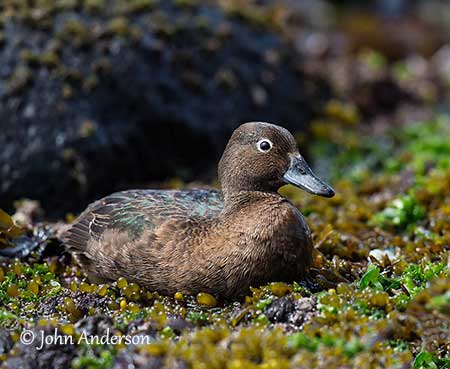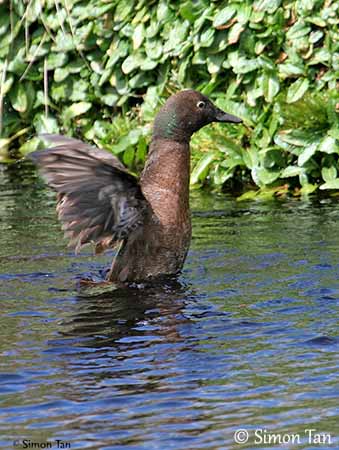
Fr: Sarcelle brune
All: Aucklandente
Esp: Cerceta de Nueva Zelanda
Ita: Anatra della Nuova Zelanda
Nd: Aucklandtaling
Sd: Aucklandkricka
Photographer:
John Anderson
John Anderson Photo Galleries
Simon Tan
PBase Bird galleries
Text by Nicole Bouglouan
Sources:
HANDBOOK OF THE BIRDS OF THE WORLD vol 1 by Josep del Hoyo-Andrew Elliot-Jordi Sargatal - Lynx Edicions - ISBN: 8487334105
GUIDE DES CANARDS, DES OIES ET DES CYGNES – de Steve Madge - Delachaux et Niestlé - ISBN: 2603013769
BirdLife International (BirdLife International)
Tiritiri Matangi Open Sanctuary
Auckland Teal or Auckland Island Teal
Anas aucklandica
Anseriformes Order – Anatidae Family
INTRODUCTION:
The Auckland Teal is endemic to Auckland Islands, S New Zealand. This is a rare species living in restricted range. This bird has reduced wings and does not fly.
DESCRIPTION OF THE BIRD:
Biometrics:
Length: 36-48 cm
Weight: M: 500-620 g – F: 420-560 g
The adult male has dark brown plumage on head and body, with pale and dark brown barring and vermiculations on flanks. The breast is mottled chestnut.
This cryptic plumage allows the bird to be almost invisible in its habitat.
In breeding plumage, we can see an iridescent green sheen on nape and neck, and a white flank patch.
The bill is bluish-black. The brown eyes are surrounded by white eyering. Legs and webbed feet are dark grey.
The female is duller, uniformly dark brown with paler underparts.
The juvenile resembles female.

CALLS AND SONGS:
The Auckland Teal is fairly silent. Both mates communicate through whistles and clucking. Outside the courtship displays, the female initiates a long series of descending quacks.
BEHAVIOUR IN THE WILD:
The Auckland Teal feeds on aquatic invertebrates such as insects and their larvae, crustaceans and molluscs. It may also eat algae.
They typically forage by probing, dabbling, upending and diving near the edge of the water. At low tide, they forage on kelp patches along the shoreline.
They usually feed at dusk and at night to avoid predation by skuas. They are often seen in pairs or small groups.
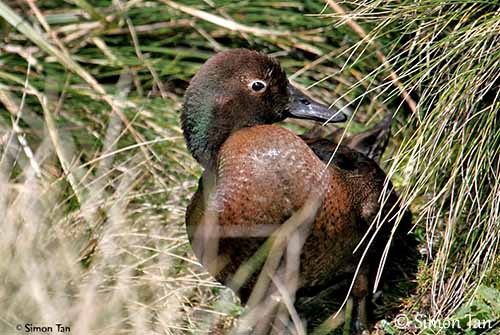
REPRODUCTION OF THIS SPECIES:
The breeding season occurs in December/January.
The Auckland Teal nests in single pairs. The nest is placed on the ground among the vegetation, under tussock or fern. This is a cup or bowl made with woven grass and lined with down.
The female lays 5-6 eggs and incubates alone during 29-30 days, while the male protects the territory. The chicks have brown down above and buffish underparts, and streaked face. They fledge between 50 and 55 days after hatching (in captivity). Both adults share most of nesting duties.
PROTECTION / THREATS / STATUS:
The Auckland Teal is a rare species with restricted range. They are threatened by introduced predators and degradation of the habitat by cattle.
The population is estimated at 600/2,000 mature individuals. The species is listed as Vulnerable.
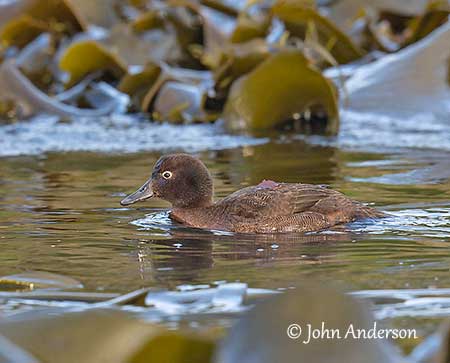
The Auckland Teal can be strongly territorial during the breeding season, and both sexes defend the area.
They are monogamous and have long-term pair-bonds. Both mates are living together all year round, and usually, the male remains with the female and the chicks, and takes parts in some nesting duties except incubation.
During the breeding season, they remain in the shelter of the vegetation during the day for resting, and they feed only at night. After the breeding season, they occur mainly in estuaries where they also feed by day according to the tide.
The Auckland Teal is sedentary. In spite being flightless, it is able to walk and run quickly on the ground. They only move within their reduced range according to food resources.
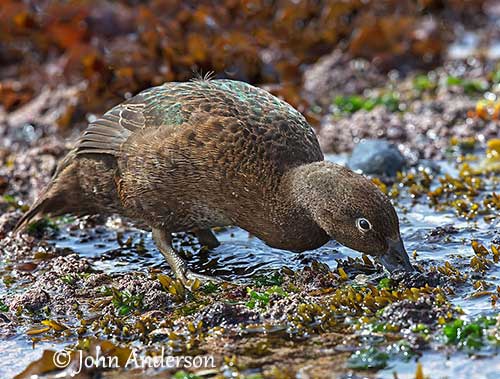
RANGE:
The Auckland Teal occurs on the islets off Auckland Islands. It was formerly present on Campbell Island too.
HABITAT:
The Auckland Teal frequents sheltered coastlines where it breeds in the thick coastal vegetation used as protection for the nest-site. It can be found inland too, mainly during the day for cover, usually in marches and pools, 100-200 metres up small streams. It also feeds in kelp beds where its brown plumage is a good camouflage.
After dark, it forages along the shorelines.
